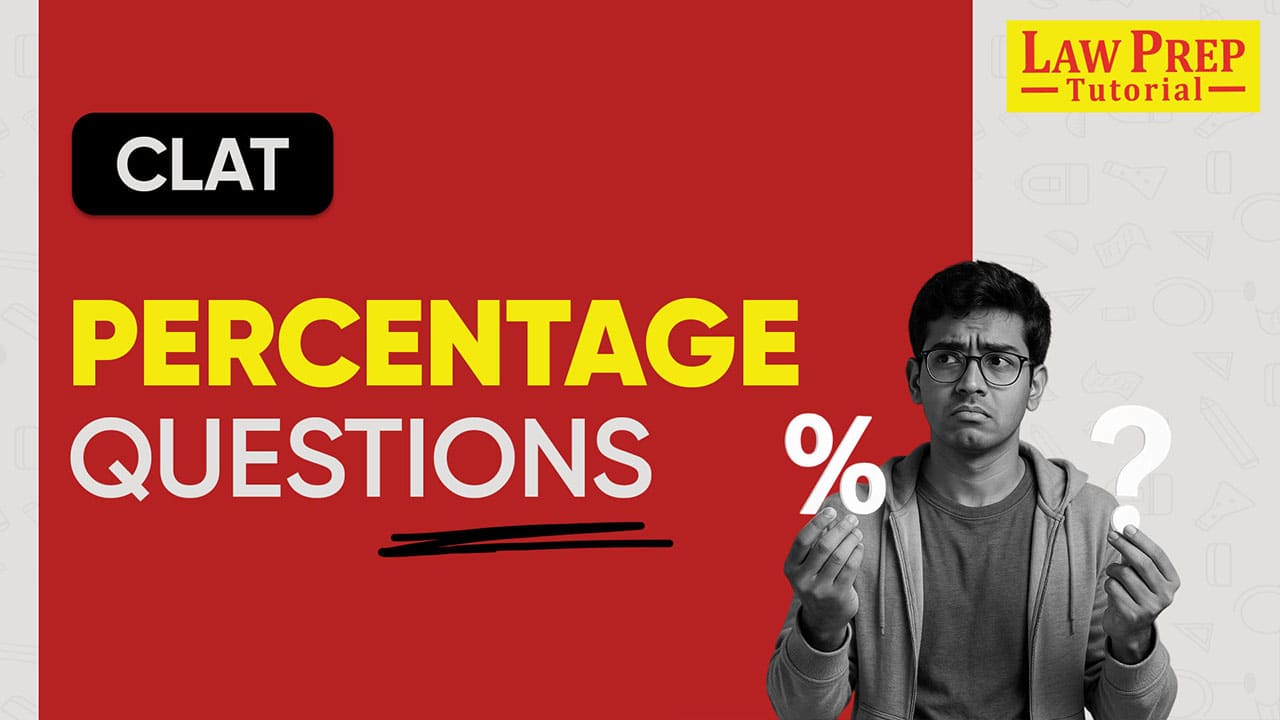Percentage questions in CLAT are crucial for aspirants as they form a significant part of the quantitative techniques section. These questions frequently appear in the exam, making it essential to master them.
Regular practice is key to improving accuracy and speed. To excel, solve a variety of problems, and take CLAT mock tests and practice with previous year’s question papers of CLAT.
These resources will help you understand the question patterns and enhance your problem-solving skills.

Importance of Quantitative Techniques in CLAT
The quantitative techniques section of CLAT plays a crucial role in evaluating a candidate’s mathematical and analytical skills. This section includes questions on various topics, including percentages, which test a candidate’s ability to interpret data, solve problems efficiently, and make accurate calculations.
A strong performance in this section can significantly boost the overall score, as it contains straightforward questions that, when understood and practiced well, can be solved quickly and correctly.
| Subjects | No. of Questions | Weightage |
| English Language | 22-26 | 20% |
| Current Affairs, including General Knowledge | 28-32 | 25% |
| Legal Reasoning | 28-32 | 25% |
| Logical Reasoning | 22-26 | 20% |
| Quantitative Techniques | 10-14 | 10% |
Upcoming CLAT Exams:
Percentage Questions for CLAT
Following are the Percentage-based Questions that you must practice if you are preparing for CLAT 2026:
Passage 1:
Quantity of food grains produced by various farmers in a year (Quantity in kilograms)
| Food Grains Farmers | Corn | Rice | Jowar | Wheat | Bajra |
| P | 450 | 200 | 150 | 275 | 145 |
| Q | 140 | 180 | 220 | 225 | 120 |
| R | 300 | 540 | 320 | 100 | 50 |
| S | 150 | 460 | 480 | 350 | 200 |
| T | 190 | 285 | 315 | 240 | 265 |
| U | 280 | 190 | 130 | 115 | 140 |
Q1. The quantity of rice produced by farmer T is approximately what per cent of the quantity of rice produced by farmer R?
(a) 53
(b) 48
(c) 56
(d) 45
Q2. What is the average quantity of total food grains produced by farmer T?
(a) 265 kg
(b) 240 kgs
(c) 259 kg
(d) 245 kg
Q3. Which farmer produced the highest total quantity of food grains in the year?
(a) P
(b) R
(c) T
(d) None of these
Q4. What is the ratio of the total quantity of corn, rice and jowar together produced by farmer U to the total quantity of wheat and bajra together produced by the same farmer?
(a) 8:3
(b) 40:17
(c) 3:8
(d) 17:40
Q5. What is the difference between the quantity of wheat produced by farmer S and the quantity of corn produced by fanner Q?
(a) 200 kg
(b) 240 kg
(c) 220 kg
(d) 210 kg
Passage 2:
Direction for question: There are 2500 residents in a village. 1,375 residents from this village speak only their local language. 200 residents of the village speak the local language as well as English. The number of residents in the village who speak the local language as well as Hindi is 625. 300 residents of the village speak all the three languages i.e. English, Hindi and the local language.
Q6. The number of residents who speak English as one of the languages forms what per cent of the total residents in the village?
(a) 12
(b) 8
(c) 20
(d) None of these
Q7. The number of residents who speak only the local language forms what per cent of the total number of residents in the village?
(a) 45
(b) 55
(c) 58
(d) 40
Q8. The number of residents who speak Hindi as one of the languages is approximately what per cent of the number of residents who speak only the local language?
(a) 67
(b) 70
(c) 61
(d) 59
Q9. What is the ratio of the number of residents who speak all the three languages to the number of residents who speak the local language as well as Hindi?
(a) 12:55
(b) 10:25
(c) 14:55
(d) 12:25
Q10. If 25 more people who can speak all the three languages come to reside in the village and 45 more people who can speak the local language and Hindi come to reside in the village, what would be the difference between the number of residents who can speak all the three languages and the number of residents who can speak the local language and Hindi?
(a) 325
(b) 330
(c) 340
(d) None of these
Law Colleges Information Related to CLAT:
| List of NLUs in India | CLAT Colleges in India |
| CLAT Colleges in Delhi | CLAT Colleges in Rajasthan |
| Top 5 NLUs in India | NLSIU Bangalore Seats |
Passage 3:
In a city XYZ, all the people read some newspaper everyday, 5478 people like to read only Times of India. 1420 people like to read only Economic Times and 2684 people like to read only Hindustan Times. 2060 people like to read only DNA and 4686 people like to read only The Hindu. 4062 people like to read only Employment News. 2466 people like to read Times of India as well as Employment News. 1540 people like to read Economic Times as well as Employment News. 3542 people like to read Times of India as well as The Hindu.
Q11. The total number of people reading Times of India forms what percent of the total number of people reading a newspaper?
(a) 32%
(b) 41%
(c) 45%
(d) 22%
Q12. The total number of people reading Employment News forms what percent of the total number of people reading some newspaper?
(a) 19%
(b) 24%
(c) 29%
(d) 34%
Q13. The total number of people reading only Hindustan Times and only DNA forms what percent of the total number of people reading some newspaper?
(a) 15%
(b) 11%
(c) 23%
(d) 17%
Q14. The total number of people reading only The Hindu forms what percent of the total number of people reading some newspaper?
(a) 7%
(b) 9%
(c) 13%
(d) 17%
Q15. How many people read only one newspaper?
(a) 16328
(b) 11642
(c) 20390
(d) 15544
Passage 4:
Out of 6500 students from the Arts wing of a college, 21% of the total number of students have majored only in Psychology. 12% of the total number of students have majored only in English Literature, and 15% of the total number of students have majored only in Politics. 7% of the total number of students have majored only in Philosophy, and 10% of the total number of students have majored only in History. 8% of the total number of students have majored in both Psychology and Philosophy. 4% of the total number of students have majored in History as well as Politics, and 11 % of the total number of students have majored in English Literature as well as Politics. 9% of the total number of students have majored in Psychology and English Literature, and 3% of the total number of students have majored in History and Philosophy.
Q16. What is the ratio of the number of students majoring in Philosophy to the number of students majoring only in Psychology?
(a) 4:5
(b) 5:6
(c) 6:7
(d) 7:8
Q17. Students majoring in History are approximately what percent of the total number of students majoring in Politics?
(a) 48
(b) 61
(c) 52
(d) 57
Q18. How many students have majored only in Politics?
(a) 650
(b) 975
(c) 780
(d) 455
Q19. What is the total number of students majoring in English Literature?
(a) 780
(b) 1495
(c) 1300
(d) None of these
Q20. Lowest number of students have majored in which subject?
(a) History
(b) Philosophy
(c) Politics
(d) English Literature
Passage 5:
A survey conducted on 1800 villages’ shows that 25% of the total villages have only adequate water supply. 15% of the total number of villages have proper supply of electricity only. 7% of the total number of villages have only proper education facilities. 12% of the total number of villages have telecommunication services only. 16% of the total number of villages have proper healthcare services only. 6% of the total number of villages have adequate water as well as supply of electricity. 8% of the total number of villages have adequate supply of water, supply of electricity as well as healthcare services. 5% of the total number of villages have proper supply of electricity, telecommunication services as well as healthcare services and 6% of the total number of villages have all the facilities.
Q21. How many villages in all have adequate water supply?
(a) 702
(b) 450
(c) 594
(d) 810
Q22. How many villages in all have adequate supply of water as well as electricity?
(a) 360
(b) 108
(c) 720
(d) 972
Q23. How many villages in all do not have proper supply of electricity?
(a) 720
(b) 850
(c) 920
(d) 1080
Q24. How many villages have only proper education facilities?
(a) 108
(b) 126
(c) 234
(d) 216
Q25. How many villages have all the facilities?
(a) 90
(b) 126
(c) 144
(d) None of these
Must Know for Every CLAT Aspirant:
| CLAT Eligibility Criteria | CLAT Exam Pattern |
| CLAT Age Limit | CLAT Marking Scheme |
| How to Prepare for CLAT? | CLAT Preparation Books |
Passage 6:
Total number of person who went for a bakery is 730. They like 3 different Snacks (Chips, Kurkure and TakaTak). They like at least one or at most 3 snacks. 60 persons like all the three snacks. The person who like kurkure is 430 while the person who like only kurkure is 180. The person who like chips and kurkure is 150. The person who like only chips is 50 more than the person who like only Takatak and Kurkure. The person who like chips and takatak is 10 more than the person who like only takatak.
Q26. Find the number of persons who like chips and Kurkure but not takatak?
(a) 380
(b) 420
(c) 350
(d) 450
Q27. Person who like only two Snacks is what % of the persons who like only one snacks?
(a) 85%
(b) 45.2%
(c) 55.8%
(d) 65.6%
Q28. Find the ratio between the person who like chips and takatak to that of the person who like takatak and kurkure but not chips?
(a) 11: 38
(b) 5 :17
(c) 23 : 34
(d) 12 : 19
Q29. Total number of persons who like Chips and Kurkure is what % of total number of person who likes only chips and TakaTak?
(a) 225%
(b) 250%
(c) 275%
(d) 300%
Q30. Total number of persons who like all three snacks is what % less than the person who like only kurkure?
(a) 85.89%
(b) 45.74%
(c) 66.67%
(d) 58%
Passage 7:
The given table chart shows the percentage of total marks obtained by the four different students A, B, C and D in Physics out of the maximum marks in that subject, the percentage of total marks obtained by four different students in English out of the maximum marks in that subjects and the total marks obtained by four different students in Chemistry.
Total marks obtained by each students = Physics + English + Chemistry
| Students | Total marks obtained in Physics (120) | Total marks obtained in English (100) | Total marks obtained in Chemistry |
| A | 75% | 88% | 80% of total marks obtained in Physics |
| B | 60% | 64% | 20% of total marks obtained in all three subjects |
| C | 50% | 55% | Five-six of total marks obtained in Physics |
| D | 80% | 70% | 10% less than total marks obtained in English |
Note: The maximum marks in Chemistry is 80
Q31. Find the difference between total marks obtained by A in Chemistry and total marks obtained by B in Physics and English together?
(a) 64
(b) 56
(c) 78
(d) 81
Q32. Total marks obtained by D in Physics and Chemistry together is how much percentage more than total marks obtained by C in Physics?
(a) 120%
(b) 145%
(c) 165%
(d) 100%
Q33. Out of total marks obtained by E in all three subjects, 25% of marks were obtained in Chemistry. If the total marks obtained by E in Chemistry is two times of total marks obtained by B in Chemistry, then find total marks obtained by E in Physics and English?
(a) 218
(b) 154
(c) 195
(d) 204
Q34. If the passing marks in Chemistry is 55% of maximum marks, then how many students scored more than passing marks in Chemistry?
(a) 1
(b) 3
(c) 4
(d) 2
Q35. Total marks obtained by C in all three subjects is what percentage of the maximum marks of all three subjects?
(a) 60%
(b) 48%
(c) 72%
(d) 55%
Resources for CLAT PG Preparation:
Passage 8:
The given pie chart shows the percentage distribution of the difference between the number of boys and girls who applied for the common entrance test on five different years i.e. 2001, 2002, 2003, 2004 and 2005 and the given table shows the ratio of the number of boys to girls who applied for the common entrance test in five different years.
Q36. Find the sum of the total number of students who applied for the common entrance test in 2004 and the average number of boys who applied for the common entrance test in 2001 and 2003 together.
(a) 920
(b) 750
(c) 560
(d) 840
Q37. Find the average number of girls who applied for the common entrance test in 2001, 2002 and 2004 together.
(a) 360
(b) 320
(c) 340
(d) 380
Q38. In the year 2002, the number of girls who appeared for the common entrance test is 75% out of the number of girls who applied for the common entrance test, then find the ratio of the number of boys who applied for the common entrance test in 2001 to the number of girls who did not appear for the common entrance test in 2002?
(a) 7:6
(b) 11:3
(c) 4:5
(d) 9:7
Q39. Number of boys who applied for the common entrance test in 2002 and 2004 together is what percentage more than the number of girls who applied for the common entrance test in 2005?
(a) 45%
(b) 30%
(c) 75%
(d) 50%
Q40. If the number of boys and girls who applied for the common entrance exam in 2006 is 40% and 25% more than that of the previous year respectively, then find the total number of students who applied for the common entrance test in the year 2006.
(a) 680
(b) 510
(c) 730
(d) 450
Free CLAT Study Material for You:
| CLAT Previous Year Papers PDF | CLAT Sample Papers |
| CLAT Syllabus PDF | Free CLAT Coaching |
| CLAT Current Affairs | CLAT Topper Interviews |
| CLAT Videos | CLAT Mock Tests |
Passage 9:
In the State of UP total number of suspects from Covid- 19 is 25000. Ratio of total number of suspect on UP to MP is 25:16. Suspected people are divided into three categories i.e. Quarantine, Tested Positive and Tested Negative.
For UP – Total number of person sent for Quarantine is 66 % of Total number of persons tested positive and tested negative together. While Ratio between tested positive to tested negative is 7:8
(Note:- Ratio of Male and Female Tested positive From UP=17:18, while Total female tested negative from Covid- 19 is 3000. Also, Total male from UP is 15000)
For MP – Number of persons tested negative from Covid- 19 is 42 % of the number of persons Tested positive from Covid-19 from UP state. While number of person Sent for Quarantine is th of the number of persons Tested positive from Covid-19
(Note:- Total number of female from MP is 5400, while number of female tested positive is 1000 less than the number of male tested positive from state UP. Also, 2000 male is tested negative in MP)
Q41. Total female tested positive from both the state were what % more or less than the Total female tested negative from both the state?
(a) 65%
(b) 35%
(c) 25%
(d) 50%
Q42. Total male sent for quarantine is how much more or less than the total male tested positive from Covid-19?
(a) 5400
(b) 4600
(c) 3800
(d) 4200
Q43. Find the ratio between Total female tested positive and negative from both the state to that of total male tasted positive and negative from both the state?
(a) 8:7
(b) 3:7
(c) 7:9
(d) 5:7
Q44. Find total number of quarantine person from state UP is how much more or less than the total number of person not Quarantine from MP?
(a) 1400
(b) 1200
(c) 1600
(d) 1000
Q45. Quarantine male from UP and MP together is what % of total person quarantined together from UP and MP?
(a) 44.78%
(b) 36.55%
(c) 58.46%
(d) 68.24%
Passage 10:
3 pizza shops A, B and C sells veg pizza and non-veg pizza. Respective ratio between number of vegetarian and non-vegetarian pizzas sold by pizza shop A was 9 : 7 and that sold by pizza shop B was 3 : 4. The number of pizzas (Veg + Non veg) sold by pizza shop C was 108 and respective ratio between number of vegetarian and non-vegetarian pizza sold by pizza shop C was 7 : 5. Total number of pizza sold by all three pizza shop was 376. Number of veg pizza sold by pizza shop A was 20% more than the veg pizza sold by pizza shop B.
Q46. If cost of each veg pizza and each non-veg pizza sold by shop B is Rs 200 and Rs 300 respectively then find the total amount obtained by shop B (in Rs).
(a) 40,000
(b) 36000
(c) 48000
(d) 32000
Q47. What is the ratio of veg pizza sold by shop A & C together to the non-veg pizza sold by shop B & C together.
(a) 27 : 25
(b) 27 : 29
(c) 29 : 27
(d) 25 : 27
Q48. What is the average of veg pizza sold by all shops?
(a) 61
(b) 68
(c) 62
(d) 65
Q49. Total veg pizzas sold by Shop A and C are what percent of total non-veg pizza sold by shop B & C?
(a) 113%
(b) 108%
(c) 109%
(d) 112%
Q50. If Veg pizza sold by shop B is increased by 33 % and non-veg pizza sold by shop A is increased by 75% then what is the sum of veg pizza sold by B and non-vegpizza sold by A after increment.
(a) 178
(b) 186
(c) 198
(d) 200
Key resources to explore after your CLAT exam
| CLAT 2026 Result | CLAT 2026 Answer Key |
| CLAT 2026 Counselling | CLAT 2026 Admit Card |
| CLAT Marks vs Rank | CLAT 2026 College Predictor |
| CLAT 2026 Question Paper | CLAT 2026 Toppers |
| CLAT 2026 Rank Predictor |
Why Percentage Questions in CLAT Are Important?
- Frequent Appearance: Percentage-based questions regularly appear in the CLAT exam. Understanding and mastering these questions can significantly improve your overall score.
- Foundation for Other Topics: Many quantitative problems, such as profit and loss, discounts, and data interpretation, rely heavily on percentage calculations. A strong grasp of percentages aids in solving a variety of related questions.
- Real-World Application: Percentages are used extensively in real-life scenarios, such as financial calculations, statistical data analysis, and more. CLAT tests your ability to apply mathematical concepts in practical situations, making percentage-based questions highly relevant.
- Accuracy and Speed: Percentages involve straightforward calculations that can be solved quickly if understood well. This allows you to save valuable time during the exam, which can be allocated to more complex questions.
- Boosts Confidence: Being proficient in percentage-based questions in CLAT builds confidence. Knowing that you can accurately tackle these problems gives you a psychological edge, helping reduce exam stress and improving overall performance.
- Weightage in the Quantitative Section: Given that the quantitative techniques section comprises 10% of the CLAT exam, excelling in this area can contribute significantly to your overall score. Since percentage-based questions are a staple of this section, their importance cannot be overstated.
Best Books for CLAT Quantitative Techniques
| Book Name | Author Name |
| Quantitative Aptitude for Competitive Examinations (English) | RS Aggarwal |
| Data Interpretation | BSC Publications |
| Magical Book on Quicker Maths | M Tyra |
| Quantitative Aptitude for Competitive Examinations | Pearson’s |
View CLAT Preparation Books for All Subjects!
Free Resources for CLAT Preparation
| CLAT Current Affairs | CLAT Previous Year Papers |
| CLAT Legal Updates | CLAT Express Magazine |
| Free CLAT Classes | CLAT Current Affairs Quizzes |
CLAT Previous Year Papers
To help you prepare effectively and be ready for the CLAT exam date 2026, we have shared the collection of CLAT previous year papers. These papers provide valuable insights into the exam format and types of questions asked, helping you refine your study strategy.
Checkout CLAT previous Year papers of 18 years.
Join Online CLAT Crash Course!
If you haven’t been part of any coaching program yet, consider joining the online CLAT Crash Course to enhance your preparation.
The 3-month crash course by Law Prep Tutorial is designed to give you the boost needed for success in the 2026 exam. This course covers all essential topics, provides strategic study plans, and offers intensive practice sessions.
With expert guidance and comprehensive resources, you can maximize your chances of achieving a high score.
CLAT Coaching Across Different Cities of India


